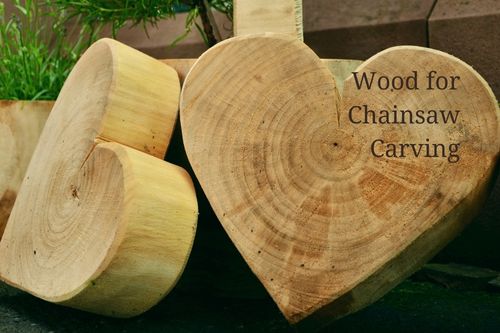When it comes to chainsaw carving, the type of wood you use is important. Some woods are easier to carve than others, and some hold up better over time.

This type of carving is achieved by using a chainsaw to carve designs into logs or tree stumps. While it may seem like any type of wood would work for this, there are actually certain types of wood that are better suited for chainsaw carving.
Below, we’ll go over the three best types of wood for chainsaw carving, as well as some things to consider when making your selection.
Best type of wood for chainsaw carving
Hardwoods
Hardwoods are the best type of wood to use for chainsaw carving. They’re strong and durable, and they have a fine grain that’s easy to carve. Common hardwoods used for carving include oak, maple, and cherry.
While hardwoods may be more difficult to carve than softwoods, they will last longer and stand up better to the elements. When choosing a hardwood for your carving project, make sure that it is dry and free of cracks or knots which can make carving more difficult.
Also make sure to specify that you need kiln-dried lumber, or else you run the risk of the wood warping or cracking after you’ve carved it.
Softwoods
Softwoods are also a good option for chainsaw carving, although they’re not as durable as hardwoods. They’re typically less expensive, though, so they may be a good choice if you’re on a budget.
Pine and fir are two of the most popular softwoods used for carving. This is because they have a softer grain which makes them easier to cut into with a chainsaw. However, softwoods do have their drawbacks. They are not as strong as hardwoods and they are more susceptible to weather damage such as rot and insect infestation.
As with hardwoods, be sure to purchase kiln-dried lumber to avoid any issues with warping or cracking.
Exotics
Exotic woods can also be used for chainsaw carving, although they can be more expensive than both hardwoods and softwoods. They tend to be very strong and durable, though, so they’re a good option if you’re looking for something that will last.
Some popular exotic woods used for carving include teak, mahogany, and ebony. As with the other types of wood mentioned above, be sure to purchase kiln-dried lumber to avoid any issues down the road.
Should you carve wet or dry wood?
There is no definitive answer to this question, as the best type of wood for chainsaw carving depends on a number of different factors. Some people may prefer to work with wet wood since it’s easier to carve and holds its shape better than dry wood. However, other people may find that working with dry wood leads to cleaner cuts and that it can be easier to control the chainsaw when carving.
Although soaking wood does make it simpler to carve, as the wood dries out, there’s a chance it might crack and become even more delicate. To avoid this issue and soften the wood for carving, it is usually easier to spray a 1:1 mixture of water and isopropyl alcohol onto the wood surface as you go along with your carved creation.
A sharp knife will also make carving easier, as it will give you more control and precision.
Ultimately, the best type of wood for chainsaw carving is a personal preference. Keep in mind different factors like strength, durability, and how it will look over time when making your decision. And make sure to take good care of the wood once you’ve carved it, by sealing and protecting it against the elements to ensure that it lasts for years to come.
Conclusion
When choosing the best type of wood for chainsaw carving, there are three main factors to consider: hardness, durability, and price. Of these three factors, hardness is the most important; softwoods are more likely to warp or crack after being carved than hardwoods are. That being said, all three types of wood – hardwoods, softwoods, and exotics – can make beautiful carvings if properly cared for.
Softwoods like pine are easy to carve but not very durable, while hardwoods like oak are more difficult to carve but will last longer. Ultimately, the best type of wood for chainsaw carving depends on your skill level and what you’re looking for in a finished piece.
